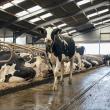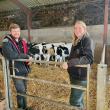Managing Cows At Grass
Mark Gorst discusses the importance of managing cows at grass through good nutrition, monitoring and assessing grass growth...

It’s important to have a plan for your grazing cows to get the most from your grass throughout the season. However, continual monitoring is key to ensure you have the flexibility to respond to these changing situations.
Nutrition
When turning cows out I look for between 2800-3100kg Dry Matter/Hectare, with residuals at 1500kg after the cows have been in. The number of days in each paddock will be determined by the number of cows, but I would use four days max as a rule of thumb.
You’ll tend to see peak grass growth from May through to July and over these months, depending on the system, we are looking at how we can maximise intakes. In early season intakes will be lower than at the height, therefore we would look at a buffer to balance the diet as intakes and grass growth improve to stabilise the rumen. We'd also take into account the protein levels looking at high energy and high digestible fibre cake to target top performing cows.
Monitoring
Maintaining cow health through rumen function is a key focus for feeding. When we are breeding, we use a high fibre base diet and cake, which helps to slow the transition through the cow so she can utilise more protein. The resultant effect is to improve fertility as there is less free ammonia in the blood which potentially can kill embryos. It also has a positive effect on milk solids, mainly butterfat, which in this current climate, if milk processors are asking for a reduction in production, then solids will have a massive cost benefit improvement to any business.
Additionally, with high raw material prices in this current market with partial housed herds, I would look to keep high yielders in and low yielders out, maximising the high yielding group and taking the cost out of low yielders. Cows will then only move into the low group at a certain “day’s in milk” and “Pd pregnant”.
As well as balancing the nutritional input of the cow, points for maintaining cow health can also be gained from monitoring the cows and assessing their environment. Lameness is a key point when grazing, as I find more bruising and damage can appear from stones as they are walking along tracks to the paddocks. Regular mobility scoring, foot bathing and triming protcols all help to keep on top of lameness and in particular digital dermatitis.
We regularly body condition score newly calved cows and ensure those with low scores have their energy levels met to stop body condition loss and further problems down the line. Any cows over half a condition score higher than the recommended level will be monitored and questions asked to why based on yield and stage of lactation. If her yield is low at low days in milk we need to look for possible ketosis, and if she is later in lactation, then she could be getting more energy through feeding than she requires.
Grass Growth
Monitoring and flexibility are the key here. If grass growth is starting to get ahead of the cows, then don’t be afraid to take a paddock or strip out and bale it to get you back into your cycle - you can never have enough bales! When trying to get as close to a 21-day rotation as possible, always keep an eye on where you will be in three weeks’ time to allow you to plan. There may not be a set rotation of paddocks when grass growth is at peak. Currently we've had an exceptionally cold April so the good grass levels prior to Easter may now be slowed.
Looking at the current climate with the spring so far and the high raw material prices, utilising grass and managing your grazing system will be the key to sustaining profit. Keep looking at contract requirements as kg’s of solids, as well as cow health, as these are becoming more beneficial for farmers to improve on.
〈 BACK














